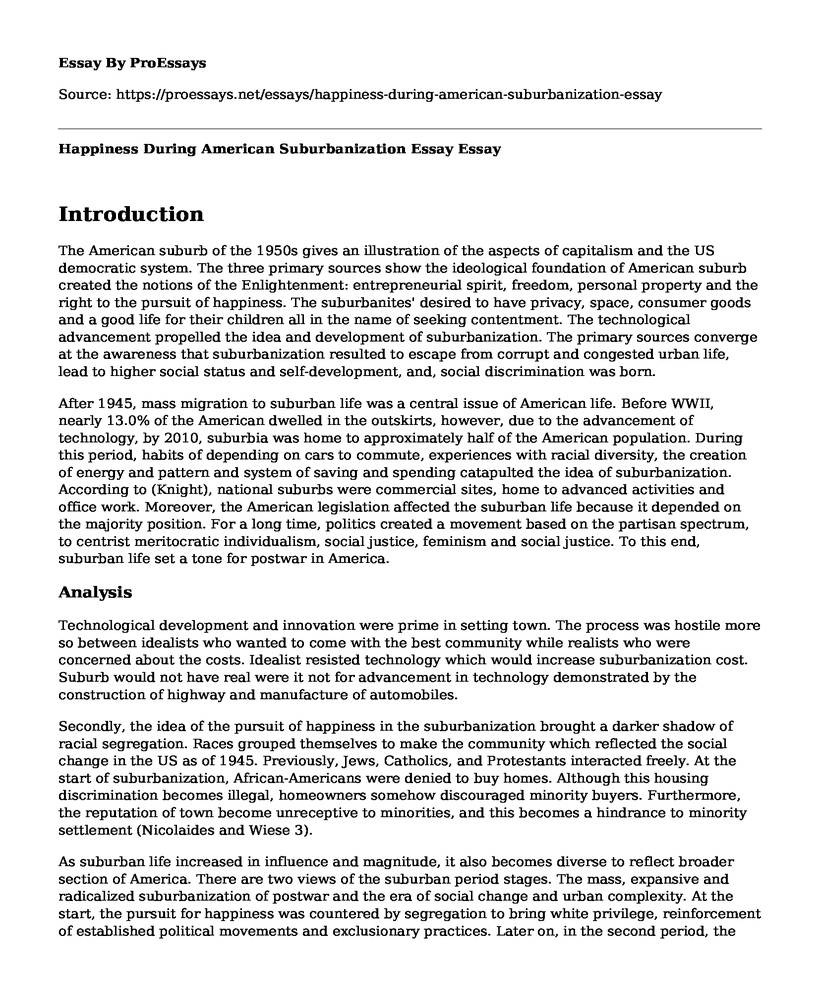Introduction
The American suburb of the 1950s gives an illustration of the aspects of capitalism and the US democratic system. The three primary sources show the ideological foundation of American suburb created the notions of the Enlightenment: entrepreneurial spirit, freedom, personal property and the right to the pursuit of happiness. The suburbanites' desired to have privacy, space, consumer goods and a good life for their children all in the name of seeking contentment. The technological advancement propelled the idea and development of suburbanization. The primary sources converge at the awareness that suburbanization resulted to escape from corrupt and congested urban life, lead to higher social status and self-development, and, social discrimination was born.
After 1945, mass migration to suburban life was a central issue of American life. Before WWII, nearly 13.0% of the American dwelled in the outskirts, however, due to the advancement of technology, by 2010, suburbia was home to approximately half of the American population. During this period, habits of depending on cars to commute, experiences with racial diversity, the creation of energy and pattern and system of saving and spending catapulted the idea of suburbanization. According to (Knight), national suburbs were commercial sites, home to advanced activities and office work. Moreover, the American legislation affected the suburban life because it depended on the majority position. For a long time, politics created a movement based on the partisan spectrum, to centrist meritocratic individualism, social justice, feminism and social justice. To this end, suburban life set a tone for postwar in America.
Analysis
Technological development and innovation were prime in setting town. The process was hostile more so between idealists who wanted to come with the best community while realists who were concerned about the costs. Idealist resisted technology which would increase suburbanization cost. Suburb would not have real were it not for advancement in technology demonstrated by the construction of highway and manufacture of automobiles.
Secondly, the idea of the pursuit of happiness in the suburbanization brought a darker shadow of racial segregation. Races grouped themselves to make the community which reflected the social change in the US as of 1945. Previously, Jews, Catholics, and Protestants interacted freely. At the start of suburbanization, African-Americans were denied to buy homes. Although this housing discrimination becomes illegal, homeowners somehow discouraged minority buyers. Furthermore, the reputation of town become unreceptive to minorities, and this becomes a hindrance to minority settlement (Nicolaides and Wiese 3).
As suburban life increased in influence and magnitude, it also becomes diverse to reflect broader section of America. There are two views of the suburban period stages. The mass, expansive and radicalized suburbanization of postwar and the era of social change and urban complexity. At the start, the pursuit for happiness was countered by segregation to bring white privilege, reinforcement of established political movements and exclusionary practices. Later on, in the second period, the broader cross-section of suburban became home to many ethnic groups, the poor, immigrants, elderly, African American, and diverse families. Therefore, suburbia brought with them a varied range of politics, lifeways, outlooks, and values
It seemed that the quest for happiness for the minorities was affected by the stubborn exclusionism by inequality and affluent suburbs. The partiality persisted in many metropolitan areas and manifested in proliferated distressed suburbs. Reforms by many groups sought to bring the metro-wide disparity to an end and promote sustainable development by the use of the regional approach. Despite these efforts of restructuring, suburban crisis and rejuvenation have continued to be complex issues in American suburbs. Hence, happiness is partially known by the minorities.
Works Cited
Nicolaides, Becky and Andrew Wiese. "Suburbanization in the United States after 1945." Urban History (2017): 2-6.
Citylab. "Archival Films Reveal How The Suburbanization Of America Was Sold." CityLab. N.p., 2015. Web. 22 June 2018.
Knight, Greg. "The Suburbanization of America: The Rise of the Patio Culture." Patioculture.net. N.p., 2014. Web. 22 June 2018.
Cite this page
Happiness During American Suburbanization Essay. (2022, Jun 22). Retrieved from https://proessays.net/essays/happiness-during-american-suburbanization-essay
If you are the original author of this essay and no longer wish to have it published on the ProEssays website, please click below to request its removal:
- Counseling for Multiculturalism and Social Justice Reflection Paper
- Mentally Ill Inmates Essay Example
- Essay Sample on Martha Nussbaum's Theory on Emotions and Ethics
- Sleep: A 4-Week Project to Improve Wellness - Essay Sample
- Southampton: 17th Worst UK City for Traffic Congestion - Essay Sample
- Essay Sample on Sudan's Pyramids: Hidden Beneath a Troubled Land
- Essay Sample on Climate Change: Pre-Industrial Activity & Global Temperature Fluctuations







